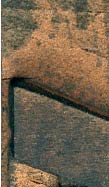|
|
||||||||||||||||||||
| introduction articles/lectures web typography style and design usability interaction composition webstyles conclusion bibliography links |
Current typographic functions can be divided into the following categories: a) Art/Autonomous typography In this case typography is mainly used for aesthetic purposes. The individual style and expression of the designer is often more important than the text. b) Communication typography 1) Impression typography The main function of impression type is to get people to read. In this case form can also be more important than legibility. But it does have a specific function: attract attention. 2) Information typography Often called 'book typography'. This is the kind of typography that is usually very subtle and its highest priority is legibility. It often involves high quantities of text. 3) Interactive/navigational typography There are many ways to represent interactive type. Besides legibility, usability is introduced as an extension of typography. Navigational typography has several functions: a) It tells the user where he/she is in relation to the rest of the content b) It tells the user where to go and how to get somewhere c) It provides direct feedback to accentuate interaction d) It accurately represents the content through language and aesthetics The communicative goal of new media differs from traditional media. The reader is now a user and that involves a different approach to typographic design that conventional methods cannot comprehend. This is were usability comes into the picture. |
 |
||||||||||||||||||
 |
Related info: Interaction design theory Nathan Shedroff The Designers Bookshelf - Type Alex White |
|||||||||||||||||||
© Copyright 2001 - 2005, Directiondesign - Jurriaan Schalken (info@directiondesign.nl)